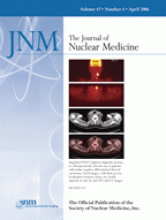Abstract
Intramyocardial injection of bone marrow cells has been proposed as a new therapeutic option for patients with chronic ischemic heart disease. We investigated whether autologous bone marrow–derived mononuclear cell injection into the myocardium of patients with drug-refractory ischemia reduces anginal symptoms, improves left ventricular (LV) function, increases myocardial perfusion, and alters the extent of scar tissue. Methods: In 25 patients (mean age ± SD, 64 ± 10 y; 21 male) with drug-refractory angina pectoris (Canadian Cardiovascular Society [CCS] class III–IV), despite optimized medical therapy and without options for conventional revascularization, bone marrow was aspirated from the iliac crest. Mononuclear cell injections were targeted at myocardial regions with stress-induced ischemia on gated 99mTc-tetrofosmin SPECT. Anginal symptoms were reassessed at 3- and 6-mo follow-up. At baseline and 3-mo follow-up, gated 99mTc-tetrofosmin SPECT and 18F-FDG SPECT were performed to assess LV function, LV volumes, myocardial perfusion (stress and rest, 17-segment model), and extent of scar tissue. Results: Mean CCS score improved from 3.4 ± 0.6 at baseline to 2.3 ± 0.6 at 3 mo (P < 0.01) and remained unchanged at 6 mo (2.3 ± 0.6; P < 0.01 vs. baseline and P = not significant [NS] vs. 3 mo). Gated 99mTc-tetrofosmin SPECT demonstrated an increased LV ejection fraction (from 47.6% ± 13.5% to 54.1% ± 16.9%; P < 0.01) and a reduced LV end-systolic volume (from 81 ± 68 mL to 75 ± 70 mL; P < 0.01). Segmental regional wall thickening increased from 34% ± 12% at baseline to 39% ± 17% at 3-mo follow-up (P = 0.01). The number of segments with stress-inducible ischemia per patient decreased from 4.6 ± 3.2 to 2.0 ± 2.6 (P < 0.01). Both segmental stress and segmental rest score improved, although the improvement in stress score was more pronounced (decrease in segmental stress score 0.22 ± 0.20 vs. decrease in segmental rest score 0.04 ± 0.06; P < 0.01). Myocardial perfusion improved in 53% of the injected segments and in 13% of the noninjected segments (P < 0.01). The percentage of myocardial segments with some extent of scar remained unchanged at 3-mo follow-up (13% vs. 12%; P = NS). Conclusion: Autologous bone marrow–derived mononuclear cell injection in patients with drug-refractory angina and chronic ischemia improves anginal symptoms, increases LV function, and predominantly enhances myocardial stress perfusion in injected segments, whereas the extent of myocardial scar tissue remains unchanged.







